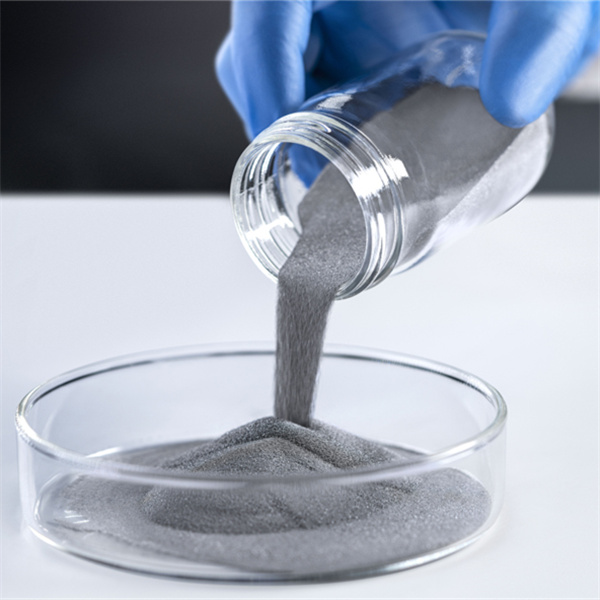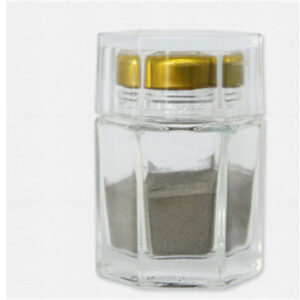用于 3d 打印的铝粉 在各行各业的增材制造中越来越多地用于制造轻质、高强度零件。本指南全面介绍了用于 3D 打印的铝粉。
用于 AM 的铝粉简介
铝是一种常用的 3D 打印材料,原因如下:
- 低密度 - 2.7 克/立方厘米
- 高比强度
- 出色的导热性和导电性
- 良好的耐腐蚀性
- 可焊接性和可加工性
- 材料成本低
铝粉的主要特性:
- 球形粉末形态
- 可控粒度分布
- 纯度超过 99.5% Al
- 在某些情况下源自回收的铝材
- 可用于粘合剂喷射、DMLS、SLM 工艺
铝粉可以打印出其他方法无法制造的轻质部件。

用于快速成型制造的铝粉类型
AM 使用各种铝合金粉末:
用于 3D 打印的铝粉类型
| 类型 | 说明 | 应用 |
|---|---|---|
| AlSi10Mg | 含硅和镁的铸造合金 | 航空航天、汽车 |
| AlSi7Mg | 含硅、镁的中等强度合金 | 工业机械 |
| 6061 | 含镁、硅的中等强度锻造合金 | 定制支架、固定装置 |
| 5XXX 系列 | 5%镁制强度 | 海洋工具 |
| 纯铝 | 非合金铝 >99.7% | 热管理、电气 |
特种合金正符合添加剂技术的要求,以匹配传统合金的特性。
组成 用于 3d 打印的铝粉
用于 AM 的铝合金粉末的典型成分:
铝印刷粉的成分
| 合金 | Al | 镁 | Si | 铁 | 铜 | 锰 |
|---|---|---|---|---|---|---|
| AlSi10Mg | 巴尔 | 0.2-0.5% | 9-11% | <0.55% | <0.05% | <0.45% |
| AlSi7Mg | 巴尔 | 0.1-0.5% | 6-8% | <1% | <0.1% | <0.1% |
| 6061 | 巴尔 | 0.8-1.2% | 0.4-0.8% | <0.7% | 0.15-0.4% | <0.15% |
| 5056 | 巴尔 | 4.5-6% | <0.4% | <0.5% | <0.1% | 0.1-0.5% |
硅能改善铸造性和流动性。镁可增强强度。最大限度地减少杂质,以确保 AM 的适用性。
铝印刷粉的主要特性
铝印刷粉的特性
| 物业 | 价值 |
|---|---|
| 密度 | 2.7 克/立方厘米 |
| 熔点 | 475-650°C |
| 导热性 | 120-180 W/mK |
| 导电性 | 35-38 MS/m |
| 拉伸强度 | 230-520 兆帕 |
| 伸长率 | 3-8% |
| 杨氏模量 | 68-72 GPa |
| 硬度 | 65-100 HB |
这些特性使铝适用于轻质、导热和导电的印刷部件。
用于 AM 的铝粉特性
铝粉特性
| 参数 | 详细信息 | 重要意义 |
|---|---|---|
| 粒子形状 | 球形 | 改善流动性 |
| 尺寸分布 | 10-100 μm | 控制零件分辨率 |
| 表观密度 | 1.2-1.8 克/立方厘米 | 影响最终部件密度 |
| 流量 | 20-30 秒/50 克 | 表示粉末的可铺展性 |
| 氧化物含量 | < 3% | 影响粉末流动和烧结 |
| 氢含量 | < 0.15% | 减少部件的气孔 |
球形度和受控的粒度分布对于铝 AM 粉来说至关重要。
铝印刷粉的规格
铝粉规格
| 参数 | 范围/限制 | 标准 |
|---|---|---|
| 颗粒大小 | 10-63 μm | ASTM B214 |
| 表观密度 | > 0.80 g/cc | ASTM B212 |
| 霍尔流量 | < 30 秒/50 克 | ASTM B213 |
| 氧化物含量 | < 3% | ASTM B237 |
| 镁、硅成分 | 合金极限 | ASTM B937 |
| 杂质 | 铁、铜、锰含量限制 | ASTM B937 |
主要粉末特性和成分均根据标准化规格进行验证。
使用的好处 用于 3d 打印的铝粉
三维打印铝材的优点
- 轻量化 - 高强度重量比
- 减少材料浪费
- 提高设计自由度和零件整合度
- 无需工具和加工
- 按需和及时制造
- 高导热性和导电性
- 卓越的耐腐蚀性
- 良好的加工和后期处理
- 中批量生产的成本效益
与传统技术相比,铝粉快速成型技术在轻质结构件和功能件方面具有显著优势。
3D 打印铝制部件的应用
3D 打印铝的行业应用
| 行业 | 组件 |
|---|---|
| 航空航天 | 机身支架、热交换器、涡轮叶片 |
| 汽车 | 底盘、动力总成部件、定制内饰 |
| 工业 | 机器人、工具、夹具、支架 |
| 消费者 | 电子外壳、无人机机身 |
| 建筑学 | 装饰板、墙面覆层 |
| 医疗 | 整形外科植入物、假肢 |
快速成型制造技术实现了以前不可能实现的铝材几何形状、整合以及跨行业定制。
如何选择打印机铝粉供应商
选择铝粉供应商
- 生产 AM 粉末的经验
- 可定制合金和颗粒大小
- 稳定的质量和可重复性
- 具有竞争力的透明定价
- 技术专长和客户支持
- 批次分析和认证数据
- 库存和更短的交付周期
- 满足需求波动的能力
- 负责任和可持续的采购
可靠的铝粉合作伙伴可根据应用要求提供定制的合格铝粉。
铝印刷粉制造商
用于 AM 的铝粉供应商
| 公司名称 | 地点 |
|---|---|
| 山特维克 | 德国 |
| AP&C | 加拿大 |
| 普莱克斯 | 美国 |
| 木匠添加剂 | 美国 |
| 高级粉末和涂料 | 美国 |
| LPW 技术 | 英国 |
这些领先的供应商提供可控的颗粒尺寸、球形形态、定制合金和广泛的鉴定数据,以确保最佳打印效果。
印刷铝粉的成本分析
铝粉成本
| 等级 | 每公斤费用 |
|---|---|
| 纯铝 | $50-$100 |
| AlSi10Mg | $55-$120 |
| 6061 合金 | $60-$150 |
| 5XXX 系列 | $65-$140 |
价格取决于合金成分、杂质含量、颗粒特性和采购量。与钛合金相比,可节省大量成本。
铝与其他印刷材料的比较
铝粉与替代品的比较
| 参数 | 铝质 | 钛 | 不锈钢 |
|---|---|---|---|
| 密度(克/立方厘米) | 2.7 | 4.5 | 8.0 |
| 拉伸强度(兆帕) | 230-520 | 900-1200 | 500-1000 |
| 导热系数(W/mK) | 120-180 | 7-16 | 15-30 |
| 导电率(MS/m) | 35-38 | 2.4 | 1.5 |
| 每公斤费用 | $50-$150 | $200-$500 | $20-$50 |
| 可印刷性 | 公平 | 困难 | 优秀 |
铝是强度、重量、导电性和成本的最佳组合。不锈钢更容易打印,但较重。钛具有挑战性。

常见问题
问:铝 AM 粉的典型粒度是多少?
答:颗粒大小通常在 10-45 微米之间,在 20-35 微米之间分布紧密,以达到最佳流量和高分辨率。
问:与 3D 打印兼容的铝材牌号有哪些?
答:AlSi10Mg、AlSi7Mg 和 6xxx 系列合金(如 6061)已获得认证。5XXX 牌号也因强度更高而越来越受欢迎。
问:哪种 AM 工艺最适合铝材?
答:DMLS、SLM 和粘合剂喷射可实现铝打印。粘合剂喷射的成型速度更快,但 DMLS 和 SLM 的机械性能更好。
问:铝粉是否需要特殊的处理预防措施?
答:细小的铝在空气中可能易燃或易爆。建议使用惰性气体手套箱进行储存和处理。
问:3D 打印铝材是否需要热处理?
答:可以,可以进行固溶处理、老化、退火或应力消除,以获得所需的材料性能和微观结构。
问:铝质 AM 零件可以实现哪些表面光洁度?
答:15 微米 Ra 左右的印刷表面可通过介质喷射、研磨、打磨和抛光进一步平滑至 1 微米 Ra 以下。
问:铝制印刷部件的性能能与块状合金相匹配吗?
答:通过优化参数和后处理,添加剂部件可获得与传统加工铝合金相当或更好的机械性能。
问:铝 AM 适用哪些设计原则?
答:印刷方向、最小的支撑、较大的内部半径以及热应力的考虑都能改善效果。壁厚最好超过 1 毫米。




